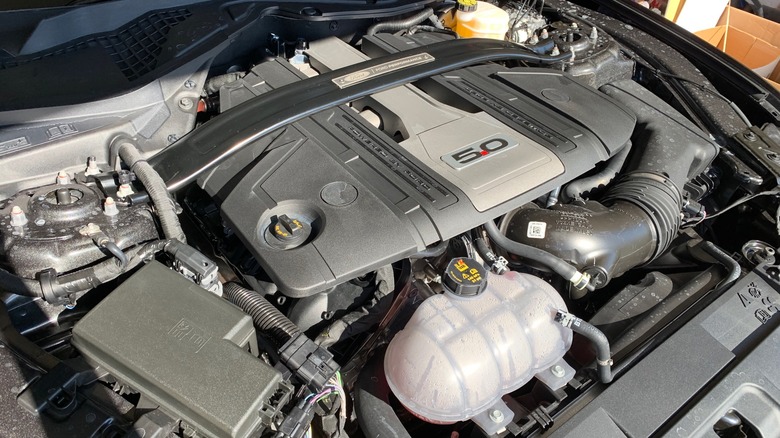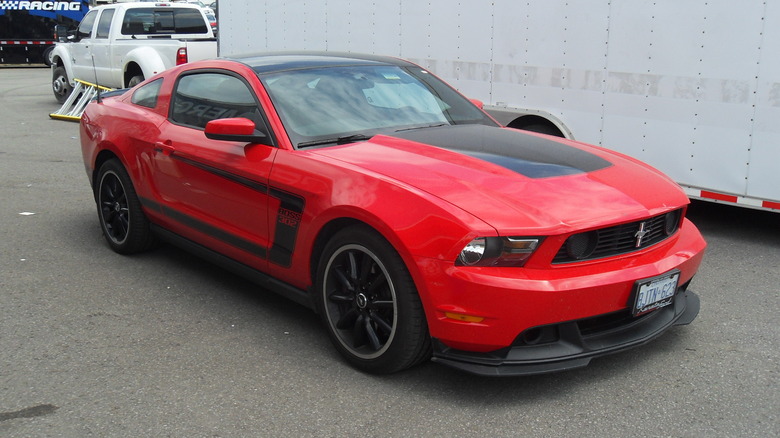Ford 5.0L Coyote Vs. 5.2L Voodoo: What's The Difference?
Ford introduced its Modular line of V8 and V10 engines back in 1990. These engines were created in an effort to completely revamp the design of its V8 engines, just as they had done with the aesthetics of its actual vehicles. The first that hit the market was a 4.6 L two-valve V8, and a four-valve variation was also available a few years later. Ford would make larger engines over the years, but that 4.6 L would be the baseline for the Modular line for 20 years. In 2010, that changed when Ford introduced the much-loved Coyote engine, which would be the first in this line to have a fun nickname.
Three years later, Ford would add another engine to the line, the Voodoo. The Coyote is a 5.0 L V8 engine, whereas the Voodoo is a 5.2 L V8. One might assume that these would be essentially the same engine where one is just slightly larger than the other, a natural progression of engine design within a company. However, that isn't exactly the case here. While that is part of what separates the Coyote and the Voodoo, their big difference is their respective crankshafts.
[Image by Jpogi via Wikimedia Commons | Cropped and scaled | CC BY-SA 4.0]
Cross-plane vs. flat-plane
Like the majority of American-made V8 engines, the Ford 5.0 L Coyote V8 has a cross-plane crankshaft. With this design, four crank pins are offset by 90 degrees each, as there are two planes intersecting perpendicularly. Basically, what you see will look like an X or a cross, hence the name. The cross-plane crankshaft allows for there to be consecutive exhaust firings, creating that signature American engine revving sound, but this design also makes for a more balanced — if heavier — operation. While it's beneficial for torque at lower speeds, the drawbacks are that it isn't as efficient of an engine nor will the rev as fast.
When the 5.2 L Voodoo V8 came into the picture, Ford decided that this engine would have a flat-plane crankshaft instead. These tend to be the kinds of cranks you will find in Europe, particularly in European-made racing vehicles. While cross-plane crankshafts have their crank pins on two planes, a flat-plane crankshaft has them all aligned on one plane. Cross-plane crankshafts require a good deal of counterweights to balance out the two planes being used, but flat-plane crankshafts don't require this, allowing for a much lighter engine that lets the vehicle rev up a lot faster and making it quite appealing to racers.
What cars are these engines used on?
The two engines' different crankshafts meant they did not have the same applications in the cars they were used for. Because the Coyote was a much more traditional engine for American vehicles where reaching the top speed as quickly as possible wasn't the goal, Ford made this V8 much more of an all-purpose engine for its vehicles. Not only can the Coyote engine be found in the Ford Mustang GT, where an engine like this makes perfect sense, but you could also get it in the F-150 pickup truck if you so wished.
The Voodoo motor, on the other hand, is a much more specialized engine. This is one for folks where speed is top priority, and that is why the Voodoo engine was developed to be used with the Ford Mustang Shelby GT350 and 350R models, offering nothing but high performance whether people are racing their cars or not. Putting such a light, performance-focused V8 under the hood of a large, full-size pickup truck wouldn't make as much sense. For that, Ford created the Predator engine, a 5.2 L V8 modeled after the Coyote. The Voodoo gets to be its own thing.


